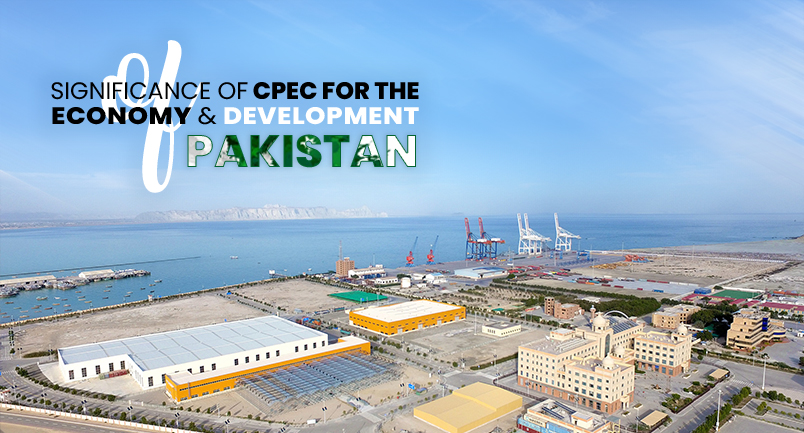
Significance of Cpec for the Economy and Development of Pakistan
SIGNIFICANCE OF CPEC FOR THE ECONOMY AND DEVELOPMENT OF PAKISTAN: A better quality of life and a greater degree of prosperity can be achieved in emerging countries thanks to economic development. China Pakistan Economic Corridor (CPEC) is part of China’s 2013 ‘One Belt, One Road initiative to increase Eurasia’s connectivity, trade, communication, and cooperation that will improve the standard of living. Long-term, CPEC encompasses China and Pakistan. Since 2013, numerous development and upgrade projects have been undertaken, totaling $47 billion. Over the next five years, it grew to $62 billion. Besides Pakistan and China, it can help the entire region and the world.
CPEC VALUE
The creation of a China-Pakistan Economic Corridor has huge regional implications. Collaboration in the realms of coastal tourism and education, as well as industrial and financial collaboration, can help diversify investment options and agricultural initiatives. It’s also good for the educational sector. It would help Pakistan fight poverty. In addition to energy and logistics hubs, cash will go to vocational training centers. It will also help promote peace and progress. It will benefit regional trade and cooperation. Regional collaboration, investment, trade diversification, political stability, and a technologically advanced energy sector are all part of the agenda.
CPEC SUPPORTS CIVILIZATION

Gwadar Port in Pakistan connects Balochistan to Karachi, Peshawar, and Lahore. From Kashgar, it flows south to the Chinese border in Southern Xinjiang. The CPEC passes through Faisalabad and Multan on its way north from Hasan Abdal. Civilizations can connect through CPEC, which is a noteworthy value. CPEC includes Gwadar Port expansion and upgrading. Gwadar Port can quickly become a regional economic hub. Pakistan’s proximity to landlocked Central Asian countries like Kazakhstan should benefit other countries in the region. Geographic ties will be improved by improving transportation and enhancing people-to-people exchanges of growth, intellectual, cultural, and regional information. Ultimately, this will lead to a well-connected area both internally and globally. Many separate places link together diverse cultures, habitats, and ideas. It also promotes free commerce, business endeavors and investments. It also improves production efficiencies and improves the flow of commodities.
CPEC’S IMPACT ON REAL ESTATE
CPEC initiative will boost Pakistan’s economic growth. The fast-growing Pakistani real estate market employs many Pakistanis. With its completion, the real estate market is likely to boom. Pakistan looks on CPEC for assistance in developing infrastructure, notably in Punjab. The CPEC includes major property in Pakistan. It also fosters the growth of various sectors and therefore jobs. The economic implications are huge. Due to the CPEC, Pakistan’s real estate market has become more secure and desirable to investors. As a result of the improving economy, the CPEC and Pakistan’s real estate market will flourish.
CPEC BOOSTS IMPORTANCE OF ZONE 2
After the Chinese government launched the CPEC, 37 “Special Economic Zones” were proposed across Pakistan. The creation of nine SEZs in Pakistan is prioritized. The CPEC has boosted the number of creative and sophisticated residential and commercial projects in Pakistan’s federal capital, Islamabad. The expansion of the CPEC has increased the number of innovative and high-end residential and commercial projects. Islamabad, Pakistan’s capital, has everything. The quick growth of Islamabad’s zone II includes Mumtaz city, Faisal town, and Top city. It attracts real estate investors as this part of the city will soon see an influx of purchasers and end-users.
RECENT DEVELOPMENTS IN CPEC
CPEC creates investment potential in various areas in Pakistan, including information technology, education, agriculture, and livestock. The Government of Khyber Pakhtunkhwa has signed memorandums of understanding with Enertech in urban development, hydropower, integrated tourism zones, and food processing. Additional actions include the Thandiani Integrated Tourism Zone, Mankyal Integrated Tourism Zone, and Ganool Integrated Tourism Zone. At Rashakai Special Economic Zone, infrastructure development is at full speed. Other recent projects include the construction of a hydrogen plant, a food processing facility, a solar plant in Rashakai, a hydropower project in Kohistan, sustainable development in Khanpur, solarization of economic zones, the Swat Transmission Line, and the Chitral to Chakdara Transmission Line. There have been electric buses installed, electric vehicle chargers installed, and an electric vehicle manufacturing facility established. All of these recent advancements have positioned Pakistan for greater prosperity.






Leave a comment: